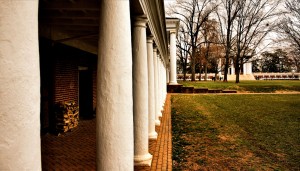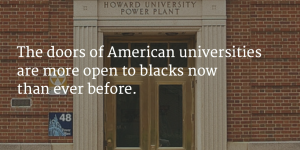Many observers, including journalists, have sounded the alarm that historically black colleges and universities in the United States are in danger of losing their identity. “Historically Black Colleges are Becoming More White,” blares one headline; and another asks “White Students at Black Colleges: What Does It Mean for HBCUs?” Questions are being raised about the future of these longstanding institutions. That’s the great news. But the problem is that claims about what is happening in historically black colleges and universities are largely false and feed popular misunderstandings of their continuing nature and contributions.
The data are clear: although a small handful of these institutions have experienced a slight increase in non-black enrollment over the last decade, most did not. Race and economic class matter more than ever in the early twenty-first century United States, and students of color often report chilly racial climates at predominantly white universities. As a result, historically black colleges and universities remain very important for black Americans as stepping stones to opportunity and as safe places for black intellectual and personal development.

The Facts about Black Colleges and Universities
Only a handful of historically black colleges and universities appear regularly in the news. The most visible institutions include Spelman and Morehouse Colleges, Howard University, and Florida A&M University. But these schools are just the tip of the iceberg. There are 100 historically black colleges and universities in the United States, and over 80 percent of them are four-year colleges and universities. Despite representing only three percent of all U.S. higher educational institutions, historically black colleges and universities enroll approximately nine percent of all black undergraduates in U.S. higher education today – and almost 11 percent of all black students attending institutions that grant bachelor’s degrees.
Students who are not black do attend these institutions, but not very many – and they constitute just a tiny fraction of enrollees. Between 2000-2010, half of all non-black students enrolled in this sector attended just ten historically black institutions—of which most are community colleges. Four-year historically black institutions experienced no increase in non-black enrollment during the 2000s. In fact, three out of four public historically black schools, and many with the largest shares of non-black enrollment, experienced significant decreases in non-black enrollment between 2000 and 2010. In other words, most historically black colleges and universities across the United States are becoming more, not less, segregated.
The Continuing Importance of Black Institutions
Beyond getting it straight that most historically black student bodies remain overwhelmingly black, it is important to understand why that is fine. Because the doors of American universities are more open to blacks now than in the past, the vast majority of black college students are enrolled at predominantly white institutions. Nevertheless, America’s historically black colleges and universities continue to pull their weight as the top producers of black graduates in many disciplines, such as science and engineering fields vital to the nation’s future. Ultimately, these institutions are able to educate and train so many minority graduates who go on to productive and successful careers in large part because they prepare black students in nurturing and supportive environments. Many of these institutions have proven unusually successful at educating first-time college goers and low-income students from minority families.

That’s the real story, even though some in the media are distracted by the idea that non-black students also attend historically black colleges and universities. Such stories fuel the narrative of a post-racial movement in America and lead the public to believe, incorrectly, that these institutions are in danger of losing their unique culture and roles because of these non-black students.
Will Public Policymakers Support Black Institutions?
Enrollments by non-black students at historically black colleges are not the most important threat to the survival of these institutions. Policies that undermine or neglect these institutions are a much greater threat. Unfortunately, federal and state-level policymakers too often overlook the special accomplishments of historically black colleges and universities when developing higher education policies – some of which can undermine these institutions.
Examples from recent federal policymaking include changes in college loan programs that may, intentionally or not, suddenly reduce enrollments and funding to historically black colleges and universities. In addition, the Obama administration is proposing a new College Scorecard ratings system that has received criticism from leaders in the historically black school community, because it could end up relying on metrics that inherently disadvantage institutions that enroll large percentages of students from disadvantaged backgrounds.
States offer even more extreme examples – including efforts in some states to simply get rid of historically black institutions. In 2014, the state of North Carolina proposed shutting down historically black Elizabeth City State University on the grounds that it is “small” and “unprofitable.” This drastic move was proposed even though Elizabeth City has consistently been a top performer in graduation rates among all historically black colleges across the country.
More generally, many historically black institutions find themselves persistently and significantly underfunded compared to predominantly white universities in their states. This situation leaves them always close to the budgetary edge, vulnerable to significant harm from even slight changes in federal or state policies that may be financially inconsequential to larger state institutions or private universities.
Despite public misunderstandings and frequent disregard from policymakers, in sum, America’s historically black colleges and universities are not relics of history. Until access and outcomes are fully equitable for black students in all U.S. institutions of higher education, these colleges and universities will remain critical for black intellectual development – and worthy of appreciation and support from all Americans.

 Research to Improve Policy: The Scholars Strategy Network seeks to improve public policy and strengthen democracy by organizing scholars working in America's colleges and universities. SSN's founding director is Theda Skocpol, Victor S. Thomas Professor of Government and Sociology at Harvard University.
Research to Improve Policy: The Scholars Strategy Network seeks to improve public policy and strengthen democracy by organizing scholars working in America's colleges and universities. SSN's founding director is Theda Skocpol, Victor S. Thomas Professor of Government and Sociology at Harvard University.
Comments 1
Why Historically Black Colleges and Universities Remain Vital in U.S. Higher Education - Treat Them Better — March 24, 2015
[…] Why Historically Black Colleges and Universities Remain Vital in U.S. Higher Education […]